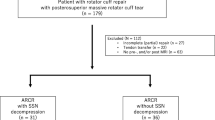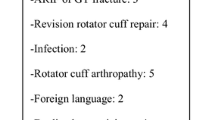Abstract
Background
Superior labrum anterior posterior (SLAP) lesions are a well-defined cause of shoulder pain and disability and may occur in conjunction with rotator cuff tears. This study was designed to prospectively evaluate the minimum 2 year results of arthroscopic repair of type II SLAP lesions in patients over the age of 45 years with and without rotator cuff tears.
Patients and methods
Thirty-five patients with symptomatic type II SLAP lesions were enrolled in the study. All patients underwent arthroscopic SLAP repair and simultaneous repairs were carried out in 17 of these patients who had concomitant full-thickness rotator cuff tears. Patients were grouped into two with regard to the presence of rotator cuff tears. The outcome was assessed by University of California at Los Angeles (UCLA) score and clinical examination (forward flexion/internal rotation/external rotation).
Results
At an average follow-up of 2.5 years, both groups displayed significant improvements in UCLA score (31.2 vs. 11.8; p < 0.01) and range of motion. Compared with the group that had SLAP and concomitant rotator cuff tears, patients in isolated SLAP group had significantly better scores in function (9.4 vs. 8.6; p = 0.045) and patient satisfaction (4.9 vs. 4.5; p = 0.039). No significant difference was found between two groups with respect to range of motion.
Conclusions
The arthroscopic repair of symptomatic type II SLAP lesions yields favorable outcomes in patients over 45 years of age and the presence of accompanying rotator cuff tears has a negative effect on the results.


Similar content being viewed by others
References
Andrews JR, Carson WG Jr, McLeod WD (1985) Glenoid labrum tears related to the long head of the biceps. Am J Sports Med 13:337–341
Snyder SJ, Karzel RP, Del Pizzo W, Ferkel RD, Friedman MJ (1990) SLAP lesions of the shoulder. Arthroscopy 6:274–279
Snyder SJ, Banas MP, Karzel RP (1995) An analysis of 140 injuries to the superior glenoid labrum. J Shoulder Elbow Surg 4:243–248
Morgan CD, Burkhart SS, Palmeri M, Gillespie M (1998) Type II SLAP lesions: three subtypes and their relationships to superior instability and rotator cuff tears. Arthroscopy 14:553–565
O’Brien SJ, Allen AA, Coleman SH, Drakos MC (2002) The trans-rotator cuff approach to SLAP lesions: technical aspects for repair and a clinical follow-up of 31 patients at a minimum of 2 years. Arthroscopy 18:372–377
Pagnani MJ, Speer KP, Altchek DW, Warren RF, Dines DM (1995) Arthroscopic fixation of superior labral lesions using a biodegradable implant: a preliminary report. Arthroscopy 11:194–198
Samani JE, Marston SB, Buss DD (2001) Arthroscopic stabilization of type II SLAP lesions using an absorbable tack. Arthroscopy 17:19–24
Yian E, Wang C, Millett PJ, Warner JJ (2004) Arthroscopic repair of SLAP lesions with a bioknotless suture anchor. Arthroscopy 20:547–551
Brockmeier SF, Voos JE, Williams RJ 3rd, Altchek DW, Cordasco FA, Allen AA (2009) Outcomes after arthroscopic repair of type-II SLAP lesions. J Bone Joint Surg Am 91:1595–1603
Coleman SH, Cohen DB, Drakos MC, Allen AA, Williams RJ, O’Brien SJ, Altchek DW, Warren RF (2007) Arthroscopic repair of type II superior labral anterior posterior lesions with and without acromioplasty: a clinical analysis of 50 patients. Am J Sports Med 35:749–753
Park JH, Lee YS, Wang JH, Noh HK, Kim JG (2008) Outcome of the isolated SLAP lesions and analysis of the results according to the injury mechanisms. Knee Surg Sports Traumatol Arthrosc 16:511–515
Kim SH, Ha KI, Kim SH, Choi HJ (2002) Results of arthroscopic treatment of superior labral lesions. J Bone Joint Surg Am 84:981–985
Rhee YG, Lee DH, Lim CT (2005) Unstable isolated SLAP lesion: clinical presentation and outcome of arthroscopic fixation. Arthroscopy 21:1099
Ellman H, Hanker G, Bayer M (1986) Repair of the rotator cuff. End-result study of factors influencing reconstruction. J Bone Joint Surg Am 68:1136–1144
Nam EK, Snyder SJ (2003) The diagnosis and treatment of superior labrum, anterior and posterior (SLAP) lesions. Am J Sports Med 31:798–810
Abbot AE, Li X, Busconi BD (2009) Arthroscopic treatment of concomitant superior labral anterior posterior (SLAP) lesions and rotator cuff tears in patients over the age of 45 years. Am J Sports Med 37:1358–1362
Forsythe B, Guss D, Anthony SG, Martin SD (2010) Concomitant arthroscopic SLAP and rotator cuff repair. J Bone Joint Surg Am 92:1362–1369
Franceschi F, Longo UG, Ruzzini L, Rizzello G, Maffulli N, Denaro V (2008) No advantages in repairing a type II superior labrum anterior and posterior (SLAP) lesion when associated with rotator cuff repair in patients over age 50: a randomized controlled trial. Am J Sports Med 36:247–253
Boileau P, Parratte S, Chuinard C, Roussanne Y, Shia D, Bicknell R (2009) Arthroscopic treatment of isolated type II SLAP lesions: biceps tenodesis as an alternative to reinsertion. Am J Sports Med 37:929–936
Ghalayini SR, Board TN, Srinivasan MS (2007) Anatomic variations in the long head of biceps: contribution to shoulder dysfunction. Arthroscopy 23:1012–1018
Sethi N, Wright R, Yamaguchi K (1999) Disorders of the long head of the biceps tendon. J Shoulder Elbow Surg 8:644–654
Wolf RS, Zheng N, Weichel D (2005) Long head biceps tenotomy versus tenodesis: a cadaveric biomechanical analysis. Arthroscopy 21:182–185
Gorantla K, Gill C, Wright RW (2010) The outcome of type II SLAP repair: a systematic review. Arthroscopy 26:537–545
Acknowledgments
We report no possible conflicts of interest with any institutions or companies and also no outside funding or grants. None of the researchers or an affiliated institute received from a commercial entity something of value related in any way to this manuscript or research.
Author information
Authors and Affiliations
Corresponding author
Additional information
We hereby state that all ethical, legal and patient rights wise considerations were fulfilled during and after this study.
Rights and permissions
About this article
Cite this article
Kanatli, U., Ozturk, B.Y. & Bolukbasi, S. Arthroscopic repair of type II superior labrum anterior posterior (SLAP) lesions in patients over the age of 45 years: a prospective study. Arch Orthop Trauma Surg 131, 1107–1113 (2011). https://doi.org/10.1007/s00402-011-1348-8
Received:
Published:
Issue Date:
DOI: https://doi.org/10.1007/s00402-011-1348-8




